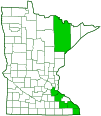upland boneset
(Eupatorium sessilifolium var. brittonianum)
Conservation • Description • Habitat • Ecology • Use • Distribution • Taxonomy
Conservation Status |
|
|||||||
| IUCN Red List | not listed |
|||||||
| NatureServe | N5 - Secure S2 - Imperiled |
|||||||
| Minnesota | Threatened |
|||||||
Description |
||
Upland bonese is a 2′ to 5′ tall, erect, perennial forb that rises on a single stem from a short caudex or rhizome. The stem is erect, sparsely branched near the top, and leafy. It is hairless except in the inflorescence. The leaves are opposite, sometimes alternate near the top, hairless, dotted with glands, and lance-shaped. They are mostly stalkless or are attached to the stem on short leaf stalks. The bases are usually broadly rounded, sometimes squared off, but do not wrap around the stem. They taper from above the base to a point at the tip. They are 2 to 5 times as long as wide. The lower leaves are 2¾″ to 6″ long and ⅓″ to 1⅛″ wide, becoming smaller as they ascend the stem. The veins are arranged like the vanes of a feather, with a single prominent midvein extending from the base to the tip and lateral veins originating from several points on each side (pinnately veined). The blade margins have sharp, forward-pointing teeth all the way to the base. The inflorescence is a branched, widely-spaced cluster of flower heads at the end of the stem and stem branch. The flower heads are cylinder-shaped. Each flower contains 5 or sometimes 6 disk florets and no ray florets. Each disk floret consists of a white flower tube with 5 short, spreading lobes. A white, forked style protrudes from the floral tube well beyond the lobes. The fruit is a tiny dark achene with a small tuft of 30 to 40 hairs. |
||
Height |
||
2′ to 5′ |
||
Flower Color |
||
White |
||
Similar Species |
||
Canada goldenrod (Solidago canadensis) is similar in appearance when not in bloom. Common boneset (Eupatorium perfoliatum var. perfoliatum) leaves are fused around the stem at their bases. They have a conspicuous network of veins, depressed on the upper surface of the blade, giving the blade a wrinkled appearance. The leaf margins have rounded teeth. Each flower contains 9 to 23 disk florets. The flowers are fragrant. The fruit has a tuft of 20 to 30 hairs. It occurs in wetter habitats. Tall boneset (Eupatorium altissimum) leaves are pointed at both ends. They have 3 prominent lateral veins. The leaf margins are untoothed near the base, toothed above the middle. Each flower contains just 5 disk florets. White snakeroot (Ageratina altissima var. altissima) leaves are shorter, wider, and on long leaf stalks. The flower heads are much larger. |
||
Habitat |
||
Dry. Oak woodland edges. |
||
Ecology |
||
Flowering |
||
August to September |
||
Pests and Diseases |
||
white snakeroot leaf miner (Liriomyza eupatoriella) |
||
Use |
||
|
||
Distribution |
||||
|
Sources |
|||
| 3/27/2023 | ||||
Nativity |
||||
Native |
||||
Occurrence |
||||
|
||||
Taxonomy |
|||
| Kingdom | Plantae (Plants) | ||
| Division | Tracheophyta (Vascular Plants) | ||
| Subdivision | Spermatophytina (Seed Plants) | ||
| Class | Magnoliopsida (Dicots) | ||
Order |
Asterales (Sunflowers, Bellflowers, Fanflowers, and Allies) | ||
Family |
Asteraceae (Sunflowers, Daisies, Asters, and Allies) | ||
| Subfamily | Asteroideae | ||
| Supertribe | Helianthodae | ||
| Tribe | Eupatorieae (bonesets, blazingstars, and allies) | ||
| Subtribe | Eupatoriinae | ||
Genus |
Eupatorium (bonesets) | ||
| Species | Eupatorium sessilifolium (upland boneset) | ||
Three varieties of Eupatorium sessilifolium have been described, based on the length and width of the leaves. Only var. brittonianum occurs in Minnesota. HHowever, there is a lot on intergradation between the varieties. Recognition of the varieties is not accepted by all toxonomists. |
|||
Subordinate Taxa |
|||
Synonyms |
|||
Common Names |
|||
upland boneset woodland boneset |
|||
Glossary
Achene
A dry, one-chambered, single-seeded seed capsule, formed from a single carpel, with the seed attached to the membranous outer layer (wall) only by the seed stalk; the wall, formed entirely from the wall of the superior ovary, does not split open at maturity, but relies on decay or predation to release the contents.
Caudex
A short, thickened, woody, persistent enlargement of the stem, at or below ground level, used for water storage.
Pinnately veined
With the veins arranged like the vanes of a feather; a single prominent midvein extending from the base to the tip and lateral veins originating from several points on each side.
Rhizome
A horizontal, usually underground stem. It serves as a reproductive structure, producing roots below and shoots above at the nodes.
Visitor Photos |
|||||
Share your photo of this plant. |
|||||
| This button not working for you? Simply email us at info@MinnesotaSeasons.com. Attach one or more photos and, if you like, a caption. |
|||||
|
|||||
MinnesotaSeasons.com Photos |
|||||
|
|||||

Slideshows |
||

Visitor Videos |
|||
Share your video of this plant. |
|||
| This button not working for you? Simply email us at info@MinnesotaSeasons.com. Attach a video, a YouTube link, or a cloud storage link. |
|||
Other Videos |
|||

Visitor Sightings |
|||||
Report a sighting of this plant. |
|||||
| This button not working for you? Simply email us at info@MinnesotaSeasons.com. Be sure to include a location. |
|||||
|
|||||
MinnesotaSeasons.com Sightings |
|||||

|
Created: Last Updated: © MinnesotaSeasons.com. All rights reserved. |
